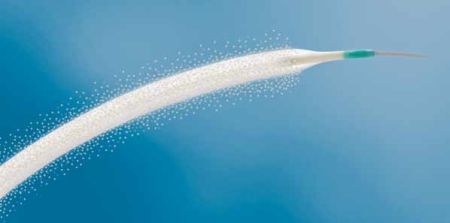BIOLUX 4EVER Study Aims to Build on Positive Results of BIOLUX P-I and 4EVER Trials
BIOTRONIK, a leading manufacturer of cardio- and endovascular devices, has announced that the first patient has been enrolled in the investigator-initiated BIOLUX 4EVER trial.
Given the positive results from each of the previous drug releasing balloon (DRB) and self-expanding stent (SES) trials, investigators were interested in exploring the combined use of the Pulsar-18 SES and Passeo-18 Lux DRB to see if the outcome could be improved further.
BIOLUX 4EVER will follow the study design of the previously completed, investigator-initiated 4EVER trial, which examined the efficacy of the Pulsar-18 SES in the treatment of Superficial Femoral Artery (SFA) lesions, but this time adding the Passeo-18 Lux DRB to the treatment. The study will enroll 120 patients treated with both products, with the primary endpoint of primary patency at 12 months.
“Studying these two devices in combination is a novel idea,” explained principal investigator Dr. Marc Bosiers, St. Blasius Hospital, Dendermonde, Belgium. “Previous studies of each device have yielded encouraging results, but we wanted to go one step further. Now, patients will be treated with both the Pulsar-18 stent and the Passeo-18 Lux, hopefully pushing the results off the charts.”
BIOLUX P-I was the first in-human study investigating the performance of the Passeo‑18 Lux DRB compared to an uncoated Passeo-18 balloon catheter in the treatment of SFA lesions. At 12 months, freedom from Target Lesion Revascularisation (TLR) was achieved in 84.6 percent of DRB patients and 58.3 percent of PTA patients. The 4EVER study investigated both the acute and long-term performance of 4F-compatible devices in treating SFA lesions. The study examined the efficacy of Pulsar stents and the feasibility of treating patients with BIOTRONIK 4F devices.
Twenty-four-month data from 4EVER for the full cohort of 120 patients showed an impressive 72.3 percent primary patency rate and a freedom from TLR rate of 82.7 percent with no significant difference between calcified and non-calcified lesions.
“The Pulsar-18 stent and Passeo-18 Lux DRB are two of our most important and forward-looking technologies,” commented Dr. Alexander Uhl, BIOTRONIK Vice President Marketing, Vascular Intervention. “The Pulsar-18 features a highly flexible, low chronic outward force design and low-profile 4F delivery system. Meanwhile, the DRB’s specially designed insertion aid has been praised by physicians for improving ease of handling while protecting the user and balloon coating from contact and damage. These innovations point to the commitment to technical excellence that BIOTRONIK stands for, and lead us to expect promising results from this new study.”
Image caption: Passeo-18 Lux Drug Releasing Balloon
Latest Articles
Research, Heart, Cardiac, Stent, Biotronik, SFA
BIOLUX 4EVER Study Aims to Build on Positive Results of BIOLUX P-I and 4EVER Trials BIOTRONIK, a leading manufacturer of cardio- and endovascular device...



























